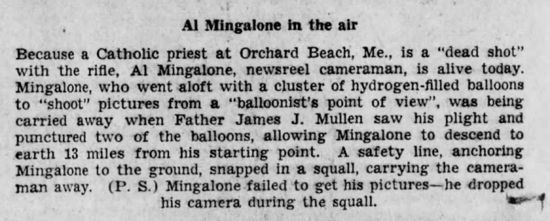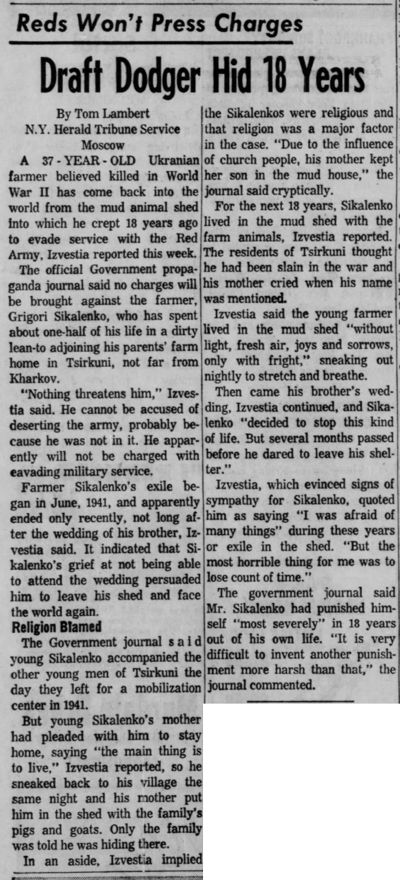July 2016
July 22, 2016
Priest shoots photographer out of sky
Larry Walters gained weird-news fame in 1982 when he tied 45 helium-filled weather balloons to a lawn chair and took an unscheduled flight over Los Angeles. However, he wasn't the first person to have this kind of aerial adventure.On September 28, 1937, news photographer Al Mingalone was on assignment in Maine trying to get photos from a "balloonist's point of view." This involved using gas-filled weather balloons to lift him into the air. But with 27 balloons pulling him upwards, the safety line keeping him tethered to the ground snapped, sending him drifting across the countryside, towards the ocean.
He floated 13 miles before a local Catholic priest, Rev. James J. Mullen, who happened to be a crack rifle shot, managed to shoot enough of the balloons to bring Mingalone back to the ground.
Read a longer account of Mingalone's flight here.


The Kane Republican - Oct 2, 1937
Posted By: Alex - Fri Jul 22, 2016 -
Comments (1)
Category: Air Travel and Airlines, 1930s
Flying Wings
In some alternate timeline, the skies are full of flying wing-type airplanes.
Posted By: Paul - Fri Jul 22, 2016 -
Comments (6)
Category: Inventions, Air Travel and Airlines, 1940s, Armed Forces
July 21, 2016
18 years beneath a dung heap
A Ukrainian man, Grigori Sikalenko, spent 18 years hiding under a dung heap in order to avoid serving in the Red Army. He went into hiding in June 1941, at the urging of his mother, who secreted him away "under the manure pile at the back of the family goat shed."He spent 18 years in hiding, until finally, in 1959, at the age of 37, he could stand it no longer and ran into town screaming, "I want to live!"
No charges were brought against him since the authorities decided he had already punished himself "most severely."
Note: The claim that he was hiding under a manure pile comes from Time magazine. But another source (the N.Y. Herald Tribune news service) offered a slightly less sensational description of his hideout, saying that he was simply "in the shed with the family's pigs and goats." Also, news sources give his first name as either Grigori or Grisha.
The Ukrainians seem to have a talent for extreme hiding. From that region also came the case of Olga Frankevich, who reportedly spent 45 years hiding beneath a bed in her sister's house in the village of Vishneve. She went into hiding in 1947, following her father's execution in a Stalinist purge, fearing she was about to suffer the same fate. She emerged in 1992.

Southern Illinoisan - Jan 12, 1960
Like a dead soul out of Gogol, a human figure rose out of a dung heap recently in the Ukrainian village of Tsirkuny, and rushed forth shrieking: "I want to live! I want to work!" Astounded neighbors, reported the Soviet newspaper Izvestia last week, found that the stinking, blinking, sunken-jawed wretch was Grisha Sikalenko, 37, a fellow they all thought had died a hero's death fighting Germans in World War II. In truth, quavered Grisha, he had deserted the very night he marched away to war, sneaked home to the hiding place his parents made for him under the manure pile at the back of the family goat shed.
"Don't mind the goats and the dung," his mother told him. "At least you'll survive." Survive he did—for 18 years in his living grave. Twice a day his mother slipped him food, scarcely paused for a word. In winters he nearly froze, and when the summer heat beat down on his reeking pit, he almost suffocated. Yet only on darkest nights would he surface for air. One night, crawling out for fresh air, he saw crosses on the rooftops and fled back in panic, mistaking the new TV aerials for signs of doom. At last, when his younger brother married and the whole village reveled round him, Grisha under his dunghill cursed the day when cowardice induced him to be buried alive. He spent a few more months screwing up his courage, then surfaced.
Once out, he found that his fears of being punished for desertion were groundless: the statute of limitations for wartime desertion had long since made him immune from prosecution, and besides, added Izvestia charitably, 18 years in a manure pile was punishment enough.
--Time - Jan 18, 1960
Posted By: Alex - Thu Jul 21, 2016 -
Comments (4)
Category: 1960s
Swinging Little Government
Now, THIS is a great campaign song AND party platform. "Our secret weapon will be the Rolling Stones!"
Posted By: Paul - Thu Jul 21, 2016 -
Comments (2)
Category: Government, Music, Bohemians, Beatniks, Hippies and Slackers, 1960s
July 20, 2016
Trashcan art thrown out by janitors
Recently another case made the news of a valuable piece of art thrown out by overzealous janitors at an art fair who didn't realize that the art in question was, in fact, art. (I'm pretty sure that Chuck has reported on a number of similar cases.)In this case, the work was a sculpture by Will Kurtz titled Keep America Great Again. — valued at $8000. The janitors got confused because the sculpture featured "a raccoon next to a trash can brimming with brightly colored rubbish."
The janitors didn't throw away the raccoon — only the trash in the can.
Actress Brooke Shields, who was curating the show, realized what had happened and was able to find the missing "art" — because apparently this kind of thing had happened at the show before, and so the janitors had been trained to temporarily store all trash in clear plastic bags before disposing of it permanently.

Posted By: Alex - Wed Jul 20, 2016 -
Comments (11)
Category: Art
The Black Godfather
FINALLY, a figure who can soothe these divisive times!
Posted By: Paul - Wed Jul 20, 2016 -
Comments (3)
Category: Crime, Movies, Racism, Stereotypes and Cliches, 1970s
July 19, 2016
Name That List, #31
What is this a list of? The answer is below in extended.- Horse Flies of the Ethiopian Region
- The Measurement of Small Holes (translated from Russian)
- Illustrated Catalogue of Fleas
- Sex Life of the Elephant Seal
- Aerodynamic Forces on Biconvex Aerofoils Oscillating in a Supersonic Slipstream
- The Gas Examiner's Working Notes
- The Highway Code
- The Rent Act and You
- Seats for Female Shop Assistants
More in extended >>
Posted By: Alex - Tue Jul 19, 2016 -
Comments (7)
Category: Name That List
The Case of Officer Hallibrand
"Driving while dictating." The automobile texting problem of its era.
Posted By: Paul - Tue Jul 19, 2016 -
Comments (3)
Category: Death, Motor Vehicles, Police and Other Law Enforcement, PSA’s, 1950s
July 18, 2016
Banned Singing of Birds
1957: In order to maintain peace and quiet at night, the Long Beach City Council proposed a ban on "singing of birds" between 11 p.m. and 7 a.m.
The Sedalia Democrat - May 9, 1957
Posted By: Alex - Mon Jul 18, 2016 -
Comments (4)
Category: Government, Regulations, 1950s
Odd Bicycles
Posted By: Paul - Mon Jul 18, 2016 -
Comments (1)
Category: Bicycles and Other Human-powered Vehicles, Eccentrics, Inventions, 1930s
| Get WU Posts by Email | |
|---|---|

| Who We Are |
|---|
| Alex Boese Alex is the creator and curator of the Museum of Hoaxes. He's also the author of various weird, non-fiction books such as Elephants on Acid. Paul Di Filippo Paul has been paid to put weird ideas into fictional form for over thirty years, in his career as a noted science fiction writer. He has recently begun blogging on many curious topics with three fellow writers at The Inferior 4+1. Chuck Shepherd Chuck is the purveyor of News of the Weird, the syndicated column which for decades has set the gold-standard for reporting on oddities and the bizarre. Our banner was drawn by the legendary underground cartoonist Rick Altergott. Contact Us |

